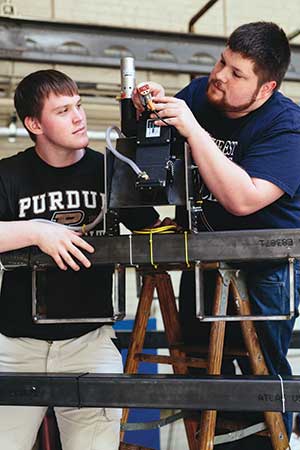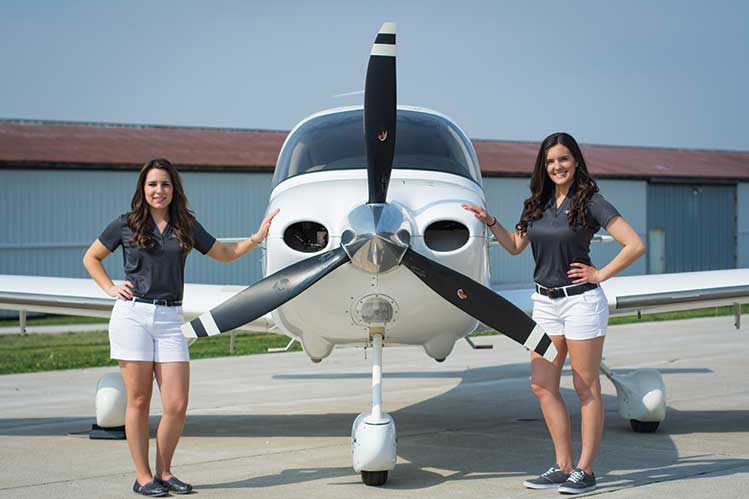 Originally published in the 2015 edition of Innovation magazine
Originally published in the 2015 edition of Innovation magazine
There’s a simple equation at the foundation of the College of Technology’s transformation: The economy has changed + students have changed = higher education needs to change to meet their needs.
This equation has led administration, faculty, staff and students to re-examine how learning takes place, how students prepare for a career, and how the college can help with education needs before, during and after college.
On May 15, the Purdue University Board of Trustees encouraged the college’s efforts and transformation by approving the renaming of the college to the Purdue Polytechnic Institute.
The concept of the Purdue Polytechnic was created in response to a call for proposals from Purdue President Mitch Daniels in spring 2013. It drew upon the successes of other educational re-imaginings, such as Olin College of Engineering, iFoundry at the University of Illinois and California Polytechnic State University (CalPoly). It also referenced education experts such as Tony Wagner, author of “Creating Innovators: The Making of Young People Who Will Change the World.”
From the start, Daniels and the Board of Trustees embraced the proposal from the college’s administration and placed it on a fast track as one of the signature Purdue Moves announced in October 2013. After it gained approval, work began almost instantly to turn the 10-page proposal into reality.
"We're looking at a three-year timeline before we have total integration," says Gary Bertoline, dean of Purdue Polytechnic. "There are a lot of moving parts, and the education and employment landscapes are constantly changing." The transformed college will approach this new way of thinking with four initiatives:
- Education research and development
- Curriculum transformation
- An innovation network
- Workforce education
Education research and development
 The process of transferring knowledge from teacher to student has not changed much in 1,000 years. While supporting tools are more sophisticated and resources more plentiful, the vast majority of classes today still rely on an expert at the front of a real or virtual room providing information to sitting students, whether the class size is 30, 300, or 30,000 (via massive open online courses).
The process of transferring knowledge from teacher to student has not changed much in 1,000 years. While supporting tools are more sophisticated and resources more plentiful, the vast majority of classes today still rely on an expert at the front of a real or virtual room providing information to sitting students, whether the class size is 30, 300, or 30,000 (via massive open online courses).
A growing amount of research indicates that this approach is no longer making the grade in preparing students for their lives and careers after graduation. Education models have not kept pace with society or the expectations and learning styles of students. And today, a majority of the facts imparted in a classroom lecture can be found via a quick Web search on a smartphone. To be successful in the 21st century, students need to be educated with a 21st-century approach.
"We want to bring together what future employers see as important with the way today's students learn and solve problems. We want to meet students where they are. They learn with and from each other, they learn through exploration and discovery, and they are used to technology, creating and sharing," Bertoline says. "They have certain expectations, too. They want guidance, and to be trusted and respected. They want to nurture their passions, to be challenged and be active learners. It’s what the economy of today and tomorrow demands."
In fall 2014, a group of first-year students enrolled in a pilot program that incorporates many of these new expectations. The program included a significantly redesigned learning environment with integrated curricula and expanded project-based learning. Participating faculty and students identified elements of the program that worked particularly well and that could be offered on a larger scale across all departments.
In this new environment, students receive academic credit by demonstrating mastery of a concept. Seat time is replaced by active learning, where students can learn at their own pace and apply their knowledge in practical ways. Faculty also adapt their teaching styles to become mentors in the process.
"I consider working with students the highest form of scholarship," Bertoline says. "It requires me to be collaborative, cooperative and reflective."
The college has had several partners in developing its new approach to technology education. Campus partners include the colleges of Liberal Arts and Education, the Honors College, Exploratory Studies, the Discovery Learning Research Center, the Center for Instructional Excellence, and the Purdue Foundations of Excellence orientation programs.
Also during the fall, faculty working with these students developed a competency-based degree proposal that could significantly change undergraduate education at Purdue and beyond. In response to another challenge by Daniels, the faculty created the proposal as an additional tool for meeting the needs of students and employers. The new Bachelor of Science degree in Transdisciplinary Studies in Technology has been approved by the University and the Indiana Commission for Higher Education (ICHE).
Curriculum transformation
When the School of Technology was formed at Purdue in 1964, its focus was the practical application of its academic programs. This focus has not changed in more than 50 years. Indeed, now as Purdue Polytechnic, the college will place a stronger and more pronounced emphasis on the applied nature of its programs.
To help introduce new students to this approach, the college will debut an integrated first-year experience in fall 2015. First-year students will benefit from the integration of themes and projects across TECH 12000 (Design Thinking in Technology), ENGL 10600 (First-Year Composition), COM 11400 (Fundamentals of Speech Communication), and major-specific introductory courses.
"Literature suggests that creating these connections and more of them improves persistence," says Nathan Mentzer, co-coordinator of TECH 12000 and assistant professor of technology leadership and innovation. "We are not only connecting the courses academically but also structurally and physically."
On the other end of the academic experience, the college is working to incorporate real-world, immersive capstone experiences as a culminating project. The School of Engineering Technology has taken the lead in creating a pipeline of industry-sponsored projects that equip students with concrete experience while helping industry partners solve some of their own problems.
Phil Sanger, professor of electrical engineering technology, leads the course for School of Engineering Technology seniors. Since its 2012-13 inception, the course has surged from three projects to 33 in 2014-15. The college plans to create similar experiences for seniors in other departments, and will look to Sanger’s success as a model for implementation. “The tasks they are achieving are ones that they couldn’t get from a traditional classroom experience,” Sanger says. “In the process of gaining valuable project and team experience, the students are helping companies find solutions that can impact consumers as well as the bottom line.”
As the transformation progresses, students will have more access to global experiences such as study abroad trips and international project teams with partner institutions. Innovation and entrepreneurship is another focal point. The college’s location in New Albany has created a pilot program that helps students develop ideas and gain the skills to bring them to market. Supported by a grant from VentureWell, the program could expand to other locations across the state. Entrepreneurial projects are also being considered as part of the overall technology curriculum.
More hands-on experiences will be added through semester or summer internships focused on design, application or research with an industry partner. By fall 2016, internships or other workforce-like opportunities will be integrated into undergraduate programs across all departments.

Innovation network
As the college’s administration and faculty formulated plans for the transformed curriculum, they realized they could provide unique resources to industry while educating students.
In industry, there is a lot of support for the development of new ideas and for launching new products. There is much less focus, however, on testing those new ideas and preparing them to be successful. Through an innovation network being coordinated throughout the college, students and faculty will demonstrate new technologies before they are ready to launch in the marketplace.
Students will learn innovation skills and research discipline while industry partners can harness students’ excitement and expertise. This portion of the transformation is still being developed. It could include additional degree programs and added projects with regional and national research programs.
Workforce education
As the college transforms its own curriculum, it will affect the way it helps others learn as well. From K-12 schools to workforce education, the college will provide learning opportunities that are experiential in nature.
“We know there are needs for STEM workers, and we want to provide a centralized area that helps fill the pipeline with more creative, innovative thinkers to work in STEM careers,” says Geanie Umberger, associate dean for engagement.
In addition, industry partners will be part of a strengthened feedback loop with faculty and students. For example, students work on industry projects alongside industry partners. Industry will benefit from the expertise of faculty and students, who in turn will benefit from seeing how classroom and project lessons translate to the workforce.
The future
The transformation of the college is an ongoing process. As the education research team continues its work, additional changes are expected in how students learn. The needs of industry also will change as new technologies and processes are developed. The college maintains a website dedicated to transformation activities; it includes new announcements, blog posts from the dean, detailed descriptions of the college’s efforts, and milestones.
